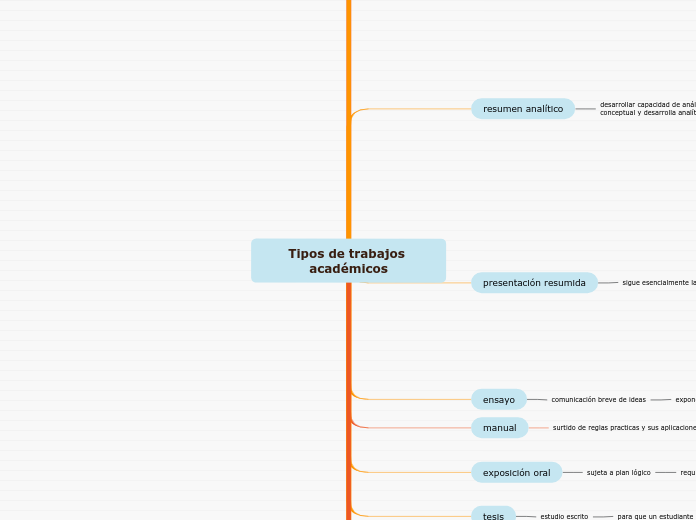by Diana Alva 5 years ago
497
Tipos de trabajos académicos

by Diana Alva 5 years ago
497

More like this

To name your story, you have to think about the overall message and what you want your audience to understand from the story. Also, make it relevant and easy to remember.
The ending of a story is essential. We all know that if the ending is weak, what happened before loses its importance. So make it unpredictable, but fair. A resolved ending answers all the questions and ties up any loose threads from the plot.
This is the closure section of the story.
See examples of possible outcomes below:
Try answering these questions to come up with a closure:
- Have all the problems been solved?
- Is there a clear picture of what happens with each character in the story?
- Has the challenge transformed your main character?
- How do the characters feel in the end?
redacción final
elaboración borrador
corrección y modificación del esquema anterior
esquema preliminar
recolección de datos
selección tema
evitar caer en rodeos y palabrería inútil
definir todo termino que se introduzca y se considere clave
debe ser sencillo, claro y preciso
The middle of the story is where you add layers of complications that will lead to the end. Reveal more about the character's journey. Did their personality go through changes? How did they overcome the challenges? And as you build up the story’s central conflict, make it more personal to that character. Also, from the middle act, you have to lead into the final act.
There wouldn't be any tension and excitement in your story if there weren't any obstacles in your character's way.
recurrir al diccionario
cuidar ortografía y sintaxis
redacción e hilvanación propias
redacción en primera o tercera persona
pasaje imposible de resumir citarlo textualmente
evitar narrar
comprender la idea con palabras propias
hacer correcciones
primer borrador
puntos básicos de los cuales se desarrolla
leer nuevamente subrayando ideas principales
lectura inicial y reflexionar
evitar la enunciatividad y descriptividad
ideas breves, lenguaje propio, objetivo y respeto al sentido original
ideas secundarias como fundamento de las principales
relación entre la ideas
buscar idea central, secundarias, ejemplos, datos de apoyo y por ultimo conclusión
ordenar lógicamente las ideas encontradas
descubrir esqueleto del texto
¿existe elaboración conceptual?
¿están demostradas la ideas?
¿hay precisión o vaguedad?
¿hay lógica en el orden del análisis?
¿se captan las ideas fundamentales?
esquema gráfico del plan
redacción y ortografía
¿hay o no equilibrio en el desarrollo del plan?
¿hay vaguedad en las ideas primarias o secundarias?¿hay unidad lógica?
¿hay o no hay contradicciones en el texto?
¿logra el autor demostrar su idea central?
In the beginning of the story (or the exposition), you will need to introduce the setting and characters. You might also want to introduce the main conflict. This part of the story is important because it gives the reader necessary background information and maybe even a first insight into a character’s personality.
The setting (time & place) of a story can change throughout the plot.